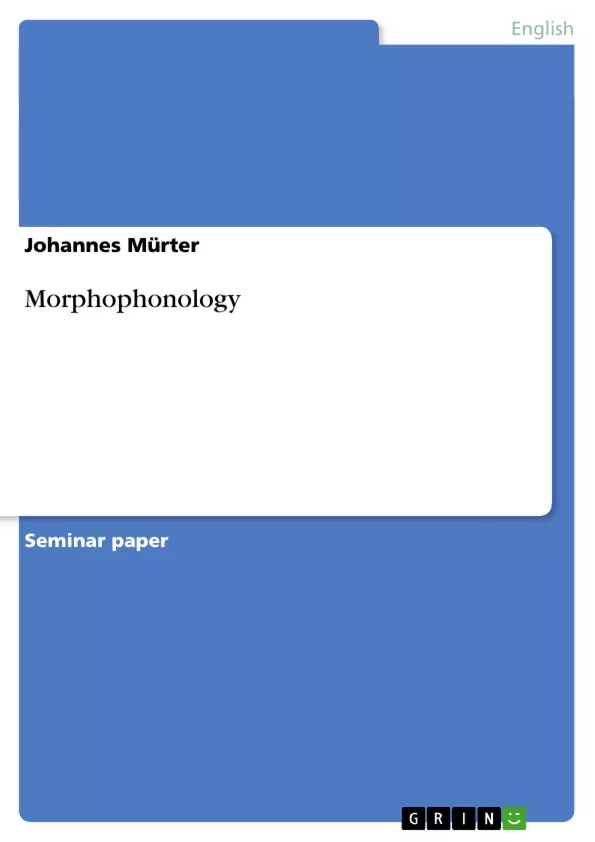In simplest terms, Morphophonology is the branch of linguistic theory which studies how allomorphs are phonologically represented. The question whether this particular subject should best be analysed as part of phonological or morphological theory seems in this respect irrelevant, as Morphophonology can be regarded as an interface between these two branches of linguistics and thus, regarding informative value, can be viewed equally well from either perspective (Kortmann 2005: 89). Later, I will address the issue of congruency, i.e. whether Morphophonology can be regarded as a separate sub-field of linguistics with independent theoretical properties and rules or rather as a merger between phonology and morphology. The latter point of view obviously begs the question whether morphological rules subsequently affect pronounciation or whether phonological properties determine not only the use of, but what is more, the need for allomorphs or in other words, whether, in terms of allomorphy, morphology precedes phonology or the other way around.
The aim of this paper is to present the different approaches to allomorphy as regards its phonological implications. After introducing the most important morphophonological rules of the English language, I will proceed to analysing the “Underlying Representations” on which these rules are based. Thus, following the theories first presented by Noam Chomsky and Morris Halle , I will focus on the psycholinguistic aspect of the URs as well as certain phenomena such as the so called “Trisyllabic Laxing” and sound changes or stress shifts conditioned by certain suffixes. The gigantic scope of Chomsky’s work on Universal Grammar makes it impossible to cover all of the aspects of URs as described in SPE, thus I will restrict my description of URs to only a few morphophonological phenomena that I find most fitting for this topic. Lastly, you will be presented with an alternating theory concerning the relation between allomorphy and phonology, namely Paul Kiparsky’s theory of Lexical Phonology , which postulates that an allomorph whose pronounciation in a certain morphological environment cannot be phonologically defined must be listed lexically (Spencer 1991: 118).
Inhaltsverzeichnis (Table of Contents)
- I. Introduction
- II. Morphophonology
- 1. The Morphophonological Rules of the English Language
- 2. Underlying Representations
- 3. Lexical Phonology
- III. Conclusion
- IV. Bibliography
Zielsetzung und Themenschwerpunkte (Objectives and Key Themes)
The main objective of this paper is to explore the different approaches to allomorphy as it relates to phonological implications. The paper begins by introducing the most important morphophonological rules of the English language and then delves into the analysis of "Underlying Representations" upon which these rules are based.
- The morphophonological rules of the English language
- Underlying Representations (URs)
- The psycholinguistic aspect of URs
- Morphophonological phenomena such as "Trisyllabic Laxing" and sound changes
- Lexical Phonology and its role in defining allomorphs
Zusammenfassung der Kapitel (Chapter Summaries)
I. Introduction
This chapter provides a general overview of morphophonology, defining it as the study of how allomorphs are represented phonologically. It also addresses the question of whether morphophonology is best viewed as a separate field or an intersection of phonology and morphology. The chapter discusses the relationship between morphological rules and pronunciation, particularly in terms of allomorphy, and introduces the paper's focus on different approaches to allomorphy.
II. Morphophonology
1. The Morphophonological Rules of the English Language
This section examines the phonological rules that govern the alternating pronunciation of morphemes in English. The focus is on phonologically conditioned allomorphs, such as the plural marker {-s} and the past tense marker {-d}, illustrating their complementary distribution based on their phonological environment. The section also explores the concept of phonological assimilation and how it explains the creation of allomorphs, using examples like the plural marker {-s}.
2. Underlying Representations
This section discusses the concept of "Underlying Representations" (URs), which are abstract representations of morphemes that serve as the basis for phonological rules. The section explores the psycholinguistic aspect of URs and examines how they relate to phenomena such as "Trisyllabic Laxing" and sound changes or stress shifts conditioned by suffixes. This section aims to provide a concise overview of URs and their role in morphophonology, focusing on a few key aspects relevant to the topic.
3. Lexical Phonology
This section introduces Paul Kiparsky's theory of Lexical Phonology, an alternative perspective on the relationship between allomorphy and phonology. This theory posits that allomorphs whose pronunciation in a certain morphological environment cannot be phonologically defined must be listed lexically. This section delves into the concept of lexical listing as it applies to allomorphs and offers a contrasting viewpoint to the previous sections' emphasis on rule-based phonological and morphological conditioning.
Schlüsselwörter (Keywords)
The primary terms and concepts explored in this paper include morphophonology, allomorphy, phonological conditioning, underlying representations (URs), lexical phonology, and lexical listing. The paper examines how these concepts interact to shape the pronunciation of morphemes in the English language, particularly focusing on the interplay between phonology and morphology in creating and determining allomorphs.
- Citar trabajo
- Johannes Mürter (Autor), 2009, Morphophonology, Múnich, GRIN Verlag, https://www.grin.com/document/140228




